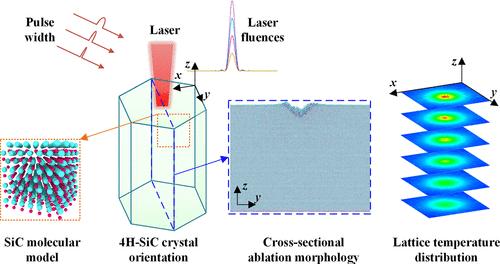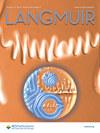线性扩展分子动力学建模模拟碳化硅晶体的皮秒激光烧蚀
IF 3.7
2区 化学
Q2 CHEMISTRY, MULTIDISCIPLINARY
引用次数: 0
摘要
通过线性放大激光焦点直径,建立了纳米级碳化硅晶体的皮秒激光烧蚀分子动力学模型,并实现了纳米级分子动力学模拟与微米级实验再现之间的相关性。通过用 37 ps 的激光脉冲宽度烧蚀碳化硅晶片表面,验证了分子动力学模型的计算精度。在此基础上,本文进一步研究了激光脉冲宽度和通量对表面烧蚀损伤和改性宽度、阈值和晶格温度的影响。结果表明,当激光脉冲宽度大于 10 ps 时,碳化硅损伤阈值随脉冲宽度的增加而增加,而改性阈值几乎不受脉冲宽度的影响。此外,还研究了晶体取向的影响,沿[1-100]晶体取向的激光辐照会引起更高的峰值温度、更大的损伤以及改性宽度和阈值,沿[0001]晶体取向的激光辐照次之,沿[11-20]晶体取向的激光辐照最低。最后,随着线性缩放值的增大,激光能量场的空间分布与实际情况的偏差更大,导致计算结果与实验结果更加一致。本文证明了该线性缩放分子动力学模型可用于研究数十微米范围内的激光烧蚀结果。本文章由计算机程序翻译,如有差异,请以英文原文为准。

Linearly Scaling Molecular Dynamic Modeling To Simulate Picosecond Laser Ablation of a Silicon Carbide Crystal
A molecular dynamics model for picosecond laser ablation of nanoscale silicon carbide crystals was established by linearly scaling the laser focal diameter, and the correlation between the molecular dynamic simulation of the nanoscale and the experimental reproduction of the microscale was achieved. The calculation accuracy of the molecular dynamic model was verified by ablating the surface of silicon carbide wafers with a laser pulse width of 37 ps. On this basis, this paper further investigated the influence of the laser pulse width and fluence on the surface ablation damage and modification width, threshold, and lattice temperature. The results showed that, when the laser pulse width is higher than 10 ps, the silicon carbide damage threshold increases with increasing the pulse width, while the modification threshold is almost unaffected by the pulse width. In addition, the influence of crystal orientation has been studied, and laser irradiation along the [1–100] crystal orientation induces a higher peak temperature, larger damage, and modification width and threshold, followed by irradiation along the [0001] crystal orientation and lowest along the [11–20] crystal orientation. Finally, with the linear scaling value increasing, the spatial distribution of the laser energy field deviates more from the actual situation, resulting in the calculated results being more consistent with the experimental results. Through this paper, it is demonstrated that this linearly scaled molecular dynamics model can be used to study laser ablation results over tens of micrometers.
求助全文
通过发布文献求助,成功后即可免费获取论文全文。
去求助
来源期刊

Langmuir
化学-材料科学:综合
CiteScore
6.50
自引率
10.30%
发文量
1464
审稿时长
2.1 months
期刊介绍:
Langmuir is an interdisciplinary journal publishing articles in the following subject categories:
Colloids: surfactants and self-assembly, dispersions, emulsions, foams
Interfaces: adsorption, reactions, films, forces
Biological Interfaces: biocolloids, biomolecular and biomimetic materials
Materials: nano- and mesostructured materials, polymers, gels, liquid crystals
Electrochemistry: interfacial charge transfer, charge transport, electrocatalysis, electrokinetic phenomena, bioelectrochemistry
Devices and Applications: sensors, fluidics, patterning, catalysis, photonic crystals
However, when high-impact, original work is submitted that does not fit within the above categories, decisions to accept or decline such papers will be based on one criteria: What Would Irving Do?
Langmuir ranks #2 in citations out of 136 journals in the category of Physical Chemistry with 113,157 total citations. The journal received an Impact Factor of 4.384*.
This journal is also indexed in the categories of Materials Science (ranked #1) and Multidisciplinary Chemistry (ranked #5).
 求助内容:
求助内容: 应助结果提醒方式:
应助结果提醒方式:


